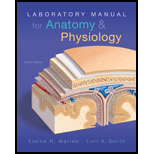
Laboratory Manual for Anatomy & Physiology (6th Edition) (Anatomy and Physiology)
6th Edition
ISBN: 9780134206332
Author: Elaine N. Marieb, Lori A. Smith
Publisher: PEARSON
expand_more
expand_more
format_list_bulleted
Textbook Question
Chapter 16, Problem 5MC
Blood proteins play an important part in (a) blood clotting, (b) immunity, (c) maintenance of blood volume, (d) all of the above.
Expert Solution & Answer
Want to see the full answer?
Check out a sample textbook solution
Students have asked these similar questions
Liver disease often results in ascites (increasing abdominal fluid) and other forms of systemic edema. This is due to the decrease in synthesis by the liver of which of the following?
(A) fibrinogen and other clotting proteins
(B) transferrin and other transport proteins
(C) cholesterol and its transport proteins
(D) albumin
John was involved in a serious accident and lost a large volume of blood. His girlfriend, Anne, gave him distilled water while trying desperately to replenish his body fluids. She added the water directly to the blood via one of his veins.
(a). How does the water get into John's blood cells?
(b). What will the result be? Why?
In blood, what solutes contribute to osmotic pressure?
A) platelets
B) RBCs
C) proteins, ions, & small molecules
D) leukocytes
Chapter 16 Solutions
Laboratory Manual for Anatomy & Physiology (6th Edition) (Anatomy and Physiology)
Ch. 16.1 - List two protective functions of blood.Ch. 16.2 - Prob. 2CYUCh. 16.2 - Are plasma proteins used as fuel for body cells?...Ch. 16.3 - How many molecules of oxygen can each hemoglobin...Ch. 16.3 - Patients with advanced kidney disease often have...Ch. 16.4 - Which WBCs turn into macrophages in tissues? Which...Ch. 16.4 - Amos has leukemia. Even though his WBC count is...Ch. 16.4 - Prob. 8CYUCh. 16.5 - What is a megakaryocyte? What does its name mean?Ch. 16.6 - Prob. 10CYU
Ch. 16.6 - Prob. 11CYUCh. 16.6 - Prob. 12CYUCh. 16.7 - Nigel is told he has type B blood. Which ABO...Ch. 16.8 - Prob. 14CYUCh. 16 - The blood volume in an adult averages...Ch. 16 - Prob. 2MCCh. 16 - Prob. 3MCCh. 16 - The most numerous WBC is the (a) eosinophil, (b)...Ch. 16 - Blood proteins play an important part in (a) blood...Ch. 16 - The white blood cell that releases histamine and...Ch. 16 - The blood cell that can become an...Ch. 16 - Which of the following does not promote multiple...Ch. 16 - The normal pH of the blood is about (a) 8.4, (b)...Ch. 16 - Suppose your blood is AB positive. This means that...Ch. 16 - Prob. 11SAQCh. 16 - Prob. 12SAQCh. 16 - Prob. 13SAQCh. 16 - What nutrients are needed for erythropoiesis?Ch. 16 - (a) Describe the process of erythropoiesis. (b)...Ch. 16 - Prob. 16SAQCh. 16 - (a) If you had a severe infection, would you...Ch. 16 - (a) Describe the appearance of platelets and state...Ch. 16 - Prob. 19SAQCh. 16 - (a) Define fibrinolysis. (b) What is the...Ch. 16 - (a) How is clot overgrowth usually prevented? (b)...Ch. 16 - How can liver dysfunction cause bleeding...Ch. 16 - Prob. 23SAQCh. 16 - Prob. 24SAQCh. 16 - Prob. 1CCSCh. 16 - Prob. 2CCSCh. 16 - Prob. 3CCSCh. 16 - Prob. 4CCSCh. 16 - Prob. 5CCS
Knowledge Booster
Learn more about
Need a deep-dive on the concept behind this application? Look no further. Learn more about this topic, biology and related others by exploring similar questions and additional content below.Similar questions
- Consider the representations A, B, and C for the three types of blood cells. (a) Identify each type of blood cell. (b) Which type is present in the highest concentration? (c) Which type is present in the lowest concentration?arrow_forwardIn an adult, the only site of red blood cell production, and the primary site of white blood cell formation, is the, (a) liver. (b) spleen. (c) thymus. (d) red bone marrow.arrow_forwardDuring erythropoiesis in the bone marroW, which is the last cell to have a nucleus? O a) proerythroblasts O b) normoblasts O c) erythrocytes O d) reticulocytesarrow_forward
- Which of the following is the cause of this type of anemia (A) lack of iron (B) lack of Vitamin B12 (C) lack of intrinsic factor (D) single amino acid substitution (glutamic acid replaces valine) (E) single amino acid substitution (valine replaces glutamic acid) (F) loss of bone marrow stem cellsarrow_forwardWhich of the following options is correct for two visible differences between the maternal red blood cell and the foetal red blood cell? Maternal Red Blood Cell Foetal Red Blood Cell (A) Larger, enclosed by capillary Smaller, not enclosed by capillary (B) Smaller, not enclosed by capillary Larger, enclosed by capillary (C) Smaller, nucleus seen Larger, no nucleus seen (D) Larger, no nucleus seen Smaller, nucleus seenarrow_forwardThe cells carry oxygen in the blood: A) PlateletsB) Red Blood CellsC) Muscle CellsD) White Blood Cellsarrow_forward
- Which statement best describes Arteries? A) They have thin walls and transport blood away from the heart B) They have thick walls and transport blood toward the heart C) They have thin walls and transport blood toward the heart D) They have thick walls and transport blood away from the heartarrow_forwardWhich of the following plasma proteins are important for the osmotic balance in the blood? a) Albumin b) Globulins c) Hemoglobin d) Fibrinogen e) Plateletsarrow_forwardThis is the liquid (made up of mostly water) that holds the other parts of the blood: A) A BloodB) PlateletsC) PlasmaD) O Bloodarrow_forward
- Which of the following is not included in the blood plasma? a) Sodium ions b) Water c) Urea d) Nitrogen gas e) Plateletsarrow_forwardJust number 24 pleasearrow_forwardWhy is the binding of oxygen to hemoglobin cooperative while the binding of oxygen to myoglobin is not? A) Myoglobin has more x-helix than hemoglobin B) Hemoglobin has more iron (Fe) atoms C) Hemoglobin has more than one subunit D) Myoglobin is affected by changes in pHarrow_forward
arrow_back_ios
SEE MORE QUESTIONS
arrow_forward_ios
Recommended textbooks for you


Haematology - Red Blood Cell Life Cycle; Author: Armando Hasudungan;https://www.youtube.com/watch?v=cATQFej6oAc;License: Standard youtube license